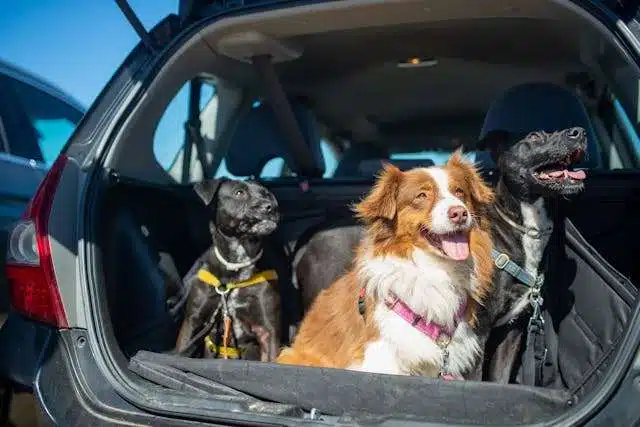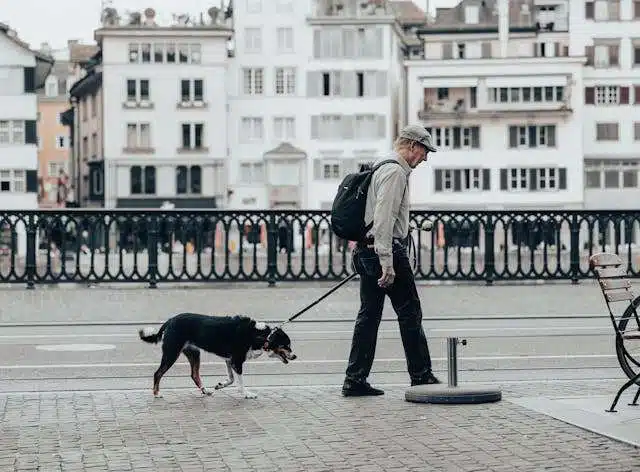While it is more common for humans to consider ways to manage anxiety, you shouldn’t forget about another family member who may be experiencing anxiety too: your dog. Therefore, we’re going to discuss some of the causes of dog anxiety, some of the signs and symptoms, as well as some ways to treat dog anxiety.
Table of Contents
ToggleWhat Causes Dog Anxiety?

First, let’s uncover the causes of dog anxiety. Why do dogs get anxious? Typically, dog anxiety is triggered by changes to their surroundings or routines. So let’s look at four specific types of anxiety to start.
1. Separation Anxiety: Dogs that are experiencing separation anxiety feel stressed when they’re not with their person.
2. Environmental Anxiety: Now, this type of anxiety is triggered by something happening in the environment. It could be something like a scary noise, like thunderstorms, or a car horn, or construction noises, even. It could even be from a stressful event, like a trip to the vet’s office for a medical procedure. Dog anxiety can come about even by simple changes, like adding new decor to your home or even rearranging furniture.
3. Social Anxiety: Now, this type of anxiety often happens when your dog is anxious around other people or other animals. This could be from poor socialization or improper social exposure as a young puppy; or it could be because of something traumatic that’s happened in your dog or puppy’s past, like being in a really rough shelter environment or coming from an overcrowded breeding facility.
4. Age-Based Anxiety: As dogs age and become older, they’re susceptible to what’s called canine cognitive dysfunction, kind of like doggy dementia. So they start to become anxious when maybe they forget the layout of the house, they become a little disoriented, they might even forget some of their human family members briefly.
What Are The Typical Anxiety In Dog's Signs And Symptoms?

Here are eight signs of anxiety to watch out for, But regardless of the type of anxiety that your dog is exhibiting, you’ll want to look out for some of these signs and symptoms. Here are some of the most common.Restlessness, like pacing, wandering, and repeatedly lying down and then getting back up again. Excessive barking and whining. Constant or excessive panting or drooling. Urinating or defecating in the house. Trembling or shaking. Showing signs of aggression, like growling, lunging, or even biting human family members. Compulsive or repetitive behaviors, like circling, or licking the air, or even overly excessively licking themselves. When you spot these recurring symptoms, take your dog to the vet because they might not just be anxiety, but they could also have some underlying medical conditions. Your veterinarian will determine if your dog has anxiety and advise you on what to do next.
How To Treat Your Dog’s Anxiety

How to treat your dog’s anxiety. Now, remember, different strategies are effective for different dogs based on their individual needs and even different situations. So working with a veterinarian, a veterinary behaviorist, or a behavior professional is a must. But here are some common treatments for your dog’s anxiety:
1. Distraction: So for minor fear-based situations or environmental anxiety, you might be able to distract your pet away from the stressor. For example, if you know a thunderstorm is about to roll in, fill a KONG with peanut butter and Pumpkin Powder and give it to your dog. Or work on basic commands while a neighbor’s dog passes by on the street. You can also entertain them with a long-lasting treat like Yak Chews.
2. Desensitization: Now, desensitization involves exposing your dog to smaller, more tolerable levels of stimuli that would otherwise cause anxiety. And over time, as your dog gets used to that, you’ll increase the intensity and the frequency at which you expose your dog to that stimuli until it’s no longer perceived as a threat. Let’s take thunderstorm anxiety or thunderstorm phobia as an example. One thing that you might do is play recordings at a really low volume of a thunderstorm happening. You do that three or four times a day for about a week, and your dog becomes acclimated to the sound and that phobia tends to dissipate. Now, if your dog has separation anxiety, they might be triggered by something as simple as jingling your keys or watching you take a suitcase out of the closet. Try doing these activities when you’re not actually leaving the house so that your dog no longer sees it as a trigger or a worrying situation. Now, before you begin, partner with your vet or behavior professional so that you don’t accidentally scare your dog in this process.
3. Counterconditioning: Now, on to one of my favorites, which is counterconditioning. Counterconditioning means that you’re gonna create a more enjoyable experience with a previous trigger. We’re gonna desensitize them first, practice a little bit of that until there’s some neutrality with how the dog feels about that trigger, and then we’re gonna pair it with something that they really like, like a treat or a toy. So for example, every time there’s a boom of thunder, I might toss a treat to my dog.
4. Anti-Anxiety Medication: So if your dog experiences anxiety on a daily basis or has more generalized anxiety, they might take something every single day, a medication under the guidance of your veterinarian to help stabilize their mood overall. For more predictable anxiety events, like car rides or thunderstorms, they tend to give you something that’s more event-specific. So something that you can give to calm your dog’s anxiety before that event actually happens.

Plenty of dogs suffer from anxiety, but the good news is that there are lots of ways to help your dog cope and even overcome it. No matter how you approach treating your dog’s anxiety, be sure to keep your vet informed just in case there might be something else going on. And don’t hesitate to reach out to a behavior professional for help. They can give you tried and true practices that you can lean on now and even in the future.



